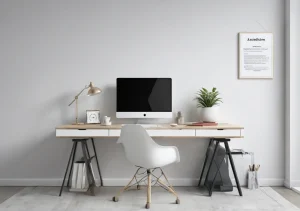Apple has long been the golden child of design, but have you ever wondered who’s behind the magic? Often, we’re so enchanted by the sleek finishes of our iPhones that we overlook the maestros creating these experiences. In this post, you’ll walk in the shoes of Apple’s design team and see just how much their roles shape our digital lives.
By the time you reach the last line, you’ll have a fresh appreciation for the creative geniuses and strategists behind your favorite Apple products – and why they matter more than you think.
Quick Takeaways:
- Apple’s design excellence stems from a team approach, with leaders like the Chief Design Officer orchestrating a vision that pairs minimalism with user-centric functionality for each product.
- Cross-functional collaboration between industrial designers, material scientists, and engineers is key to translating creative concepts into the sturdy elegance and performance of the final devices.
- UX Designers are pivotal at Apple, ensuring hardware and software synergy for seamless user experiences that foster a deep emotional connection with the brand.
Who Leads the Apple Design Vision?
When you think of Apple, sleek iPhones and MacBooks probably spring to mind. But who’s the wizard behind the curtain, crafting these iconic designs? It’s all led by a top-tier team that’s anchored by the Chief Design Officer. This role, previously held by the legendary Jony Ive, is crucial. They’re the design guru who ensures Apple’s aesthetic remains tight and consistent across all products. Now, while the Chief Design Officer spearheads the vision, they’re supported by a powerhouse of design leads who bring unique perspectives to the table. Together, they marry form with function, ensuring every product that comes out of Cupertino not only looks drop-dead gorgeous but works like a charm.
What’s the Secret Sauce in Apple’s Product Design?
So what makes an Apple product feel so… Apple? It’s the design principles, baby! Apple sticks to its guns with a minimalist mantra—”less is more.” But it’s not just about looking good; their design is deeply rooted in a user-centric philosophy. Picture this: every curve, icon, and gesture is tailored to provide a buttery-smooth user experience. And who can overlook Jony Ive’s influence? He’s been the maestro behind everything from the iMac to the iPhone, embedding simplicity and functionality into Apple’s DNA. It’s this consistent dedication to clean lines and intuitive interfaces that sets the bar in the tech world. Apple’s Design Principles are public, and they offer a unique glimpse into their approach, emphasizing clarity, deference, and depth in their design language.
How Do Apple Designers Collaborate With Engineers?
Bringing an Apple gadget to life is like a tango between designers and engineers. It’s a dynamic dance that’s all about balance. On one side, we’ve got the designers, dreaming up the future with sketches and prototypes. On the other, the engineers are the magicians who turn those dreams into reality. But here’s the kicker: Apple’s magic happens because these teams don’t just pass notes—they work shoulder to shoulder, iterating and honing every detail. This cross-functional teamwork is key to crafting products that aren’t just beautiful but also pack a punch in performance. The lore of Apple Park itself, a testament to collaboration and open workspaces, fosters unrivaled synergy between these creative and technical minds. This perfect marriage between design and engineering ensures when you hold an Apple product, you’re holding a piece of tech harmony. Apple’s design process captures how closely interwoven these roles are, ensuring that the end user gets a product that’s not just a feast for the eyes but joyous to use, day in and day out.
Remember, our journey through the roles and impact in Apple’s design team doesn’t end here—there’s more to explore and uncover. Stay tuned for more insights into the world of Apple design.
Who Decides on Apple’s Color Palettes and Materials?
When it comes to the sleek and innovative designs that Apple products are renowned for, a lot’s riding on the shoulders of some incredibly creative folks. Industrial Designers and Materials Scientists, for example, are the unsung heroes behind the textures we feel and the colors we swoon over.
These professionals not only have an eye for aesthetics but also a mind for functionality. They work in concert to forecast trends, research user preferences, and test materials to the point of obsession. Each decision plays a pivotal role in how we perceive the brand. Would the iPhone be as covetable in lime green plastic? Probably not. That’s the magic of Apple’s choice in materials and colors – it’s a mix of science, psychology, and a splash of design genius.
- Industrial Designers heed the call for both beauty and ergonomics, contouring devices that look good in a showcase and feel right in your palm.
- Material Scientists ensure that the selected substances endure the tests of time, slips, and daily wear while still holding that Apple-esque allure.
A peep into their creative process might involve testing how fingerprints look on different finishes or how light dances off the device’s surface in various lighting conditions. And here’s something you might not find on most blogs: the impact of regulations on material choice is immense, with Apple’s design team constantly juggling the aesthetic with the environmentally and legally compliant.
What Role Do UX Designers Play at Apple?
Now, if Industrial Designers are responsible for that stylish chassis of your gadget, then Apple’s User Experience (UX) Designers are the virtuosos making sure its soul is just as captivating. Think of them as the maestros orchestrating each tap, swipe, and pinch to be a symphony of intuitive interactions.
UX Designers at Apple engage in a multitude of tasks to provide that signature seamless experience:
- They conduct extensive user research to understand the needs, challenges, and contexts of Apple’s diverse user base. They’re like tech-detectives, decoding behaviors to ensure your digital journey is nothing short of spectacular.
- Crafting user interfaces (UI) goes beyond pretty icons; it’s about accessibility, consistency, and that “it just works” sensation. It’s why sliding your finger across your iPad feels more natural than scribbling your signature.
- They continuously iterate on software prototypes, putting them through rigorous user tests that would make even the best of us sweat – all to make sure the final product isn’t just good, it’s revolutionary.
Here’s where Apple’s UX department really shines: they often blur the lines between software and hardware, creating an ecosystem that feels cohesive. An example? The way your AirPods seamlessly switch from your iPhone to your Mac without missing a beat – it’s UX sorcery at its finest.
By focusing not only on the visual or the functional but on the emotional connection between product and user, Apple’s UX Designers are essentially the guardians of joy in every interaction. They embody the principle that what feels right should look right and vice versa, which is something not every tech giant manages to pull off as elegantly as Apple.
In conclusion, the roles of both the material decision-makers and the UX crafters at Apple are critical in scaling the lofty heights of innovation and user delight. Their impact gives each Apple product its signature charm and keeps users coming back for that unrivaled experience. So next time you’re marveling at your device’s latest feature or finish, remember the maestros behind the curtain, who make sure that your Apple experience remains in a league of its own.



